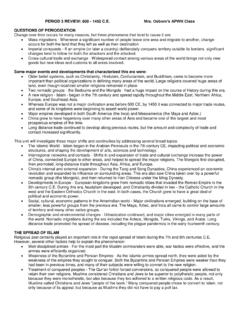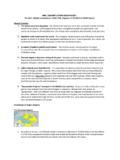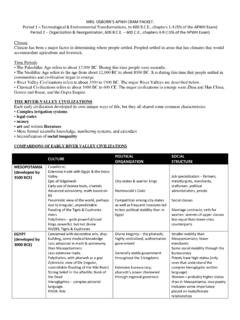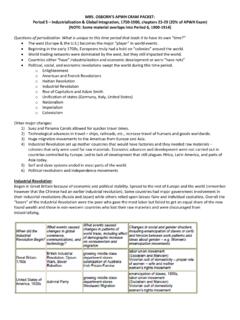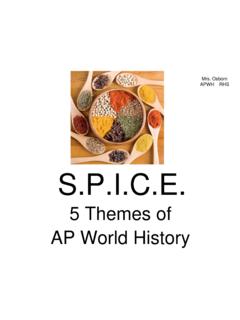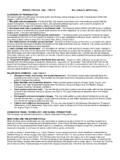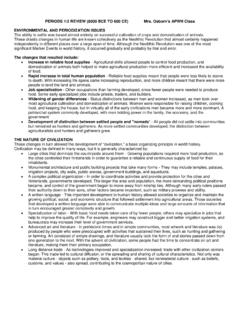Transcription of MRS. OSBORN’S APWH CRAM PACKET: Period 6 …
1 MRS. OSBORN S APWH cram packet : Period 6 Accelerating Global Change and Realignments, 1900-present, chapters 30-35 (20% of APWH Exam) (NOTE: Much of the material from 1900-1914 will be found in the Period 5 cram packet ) BIG IDEAS: The 20th Century was a time when the world got smaller. Communication and transportation made it possible to connect to every part of the globe and even into outer space. The United States came to dominate the world during the 20th century and our culture spread everywhere (McWorld) Not every part of the globe felt comfortable with the Americanization of the world.
2 American values can be interpreted as being based upon consumerism, greed, sex, and violence (remember our movies and music are everywhere). Many societies viewed this as in direct violation of their traditional values. The United States dominated the world economically and politically. We became the richest country in the history of the world. In many cases our multi-national corporations used cheap labor and cheap natural resources from the underdeveloped world to become extremely wealthy. The 20th Century has been the most violent century in history. The bloodiest official wars: 1.
3 Questions of periodization Continuities and breaks, causes of changes from the previous Period and within this Period : 1914 World War I begins; world becomes smaller through communication and transportation; WWII; end of imperialism; domination of American culture; Cold War; advanced technology; space race; nationalism 2. 3. THE NATURE OF THE WAR Even though the causes of World War II were rooted in unsettled business from World I, the nature of the war was far different from any previous conflict in world history. Some distinct characteristics of World War II are: Worldwide participation - The war was truly fought in all corners of the globe.
4 Only eleven countries did not become directly involved in the war: Afghanistan, Greenland, Iceland, Ireland, Mongolia, Portugal, Spain, Sweden, Switzerland, Tibet, and Yemen. Technology - Although airplanes and tanks had been used to some extent in World War I, they came to dominate World War II. For example, in the Pacific, airplanes attacked from giant aircraft carriers that allowed the United States navy to "hop" from one set of island to the next, finally zeroing in on Japan. In Europe airplanes on both sides bombed their opponents with high explosives and incendiaries that killed millions of people and devastated the infrastructure, particularly in large urban areas.
5 Other technologies, such as radar and more accurate and powerful weaponry, helped submarines and warships to target the enemy. the atom bomb was introduced at the end of the war. Widespread killing of civilians - Whereas civilian casualties were not unique to World War II, the war is characterized by deliberate targeting of non-military people. Because the bombings sought to destroy the industrial infrastructure, they focused on urban areas where many people lived. In some cases the bombs were intended to torment populations so that the enemy would surrender. NEW PATTERNS OF NATIONALISM Nationalism was as important a force during the 20th century as it had been in the previous era.
6 People under the control of imperialist nations continued to strive for their own identities, and new, independent nations popped up in Africa, the Indian subcontinent, and Southeast Asia. Nationalist movements also were a major cause of the late 20th century breakup of the Soviet Union, again changing the balance of world power in the post-Cold War era. NATIONALISM IN AFRICA By the early 20th century Europeans had colonized most of the African continent. Christian missionaries set up schools that educated a new native elite, who learned not only skills and literacy but western political ideas as well.
7 They couldn't help but notice the contrast between the democratic ideals they were being taught in class and the reality of discrimination that they saw around them. This observation sparked nationalist movements in many places, including: Senegal - Blaise Diagne agitated for African participation in politics and fair treatment by the French army. South Africa - Western-educated natives founded the African National Congress in 1909 to defend the interests of Africans. Ethiopia - Italy took over Ethiopia in the years leading up to World War II, and Emperor Haile Selassie led Ethiopian troops into his capital city to reclaim his title.
8 Ethiopians, as well as many other people in northern Africa responded to Allied promises of liberation and helped the Allies defeat the Germans that had occupied the area. POST WORLD WAR II STRUGGLES IN ALGERIA World War II was a humiliating experience for the French. Their armies had folded under Hitler's blitzkrieg within a few days, and they had to be liberated from German control by the other Allied powers. Both world wars devastated the infrastructure of France, and the weak parliamentary government seemed to have little control over the economy. Despite these hardships (or perhaps because of them), the French were determined to hold on to Algeria and Vietnam in Southeast Asia after World War II ended.
9 French persistence set off major revolts in both areas. In 1954 war in Algeria broke out with great brutality by both sides. In reaction to the government's inability to fight the war, the French government was totally restructured, with strong man Charles de Gaulle taking the reins of the country as its new president. Algeria finally gained their independence in 1962, but lingering bitterness and retaliation led to a stream of French-sympathizers flooding into France from Algeria. DECOLONIZATION IN SUB-SAHARAN AFRICA None of the wars for independence in sub-Saharan Africa matched the Algerian struggle in scale.
10 One by one native leaders negotiated treaties with their imperialist masters, so that by the late 1960s, the African continent was composed primarily of independent nations. Kwame Nkrumah, who in 1957 became the prime minister of Ghana, and Jomo Kenyatta, a leader of Kenya, started a Pan-African movement but the focus of nationalism was on independence for the individual colonies. Independence led to many new problems for African nations. Many border disputes occurred, since colonial boundaries often did not follow ethnic lines. The borders of some countries, such as Nigeria and Zaire, encompassed several different ethnic groups that struggled with one another for control of the country.
